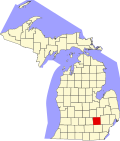Cohoctah Township, Michigan | |
|---|---|
 Cohoctah Township Hall | |
 Location within Livingston County | |
| Coordinates: 42°43′58″N83°58′35″W / 42.73278°N 83.97639°W | |
| Country | United States |
| State | Michigan |
| County | Livingston |
| Settled | 1833 |
| Organized | 1838 (Tuscola Township) 1857 (Bristol Township) 1867 (Cohoctah Township) |
| Government | |
| • Supervisor | Mark Fosdick |
| • Clerk | Barb Fear |
| Area | |
• Total | 38.4 sq mi (99.4 km2) |
| • Land | 37.9 sq mi (98.2 km2) |
| • Water | 0.46 sq mi (1.2 km2) |
| Elevation | 890 ft (270 m) |
| Population (2020) | |
• Total | 3,246 |
| • Density | 85.6/sq mi (33.1/km2) |
| Time zone | UTC-5 (Eastern (EST)) |
| • Summer (DST) | UTC-4 (EDT) |
| ZIP Codes | |
| Area code | 517 |
| FIPS code | 26-16920 [1] |
| GNIS feature ID | 1623162 [2] |
| Website | cohoctahtownship |


Cohoctah Township is a civil township of Livingston County in the U.S. state of Michigan. The population was 3,246 at the 2020 census. [3] It is located in the northwest quadrant of the county, bordered by Conway Township to the west, Deerfield Township to the east, and Howell Township to the south. To the north is Shiawassee County.


